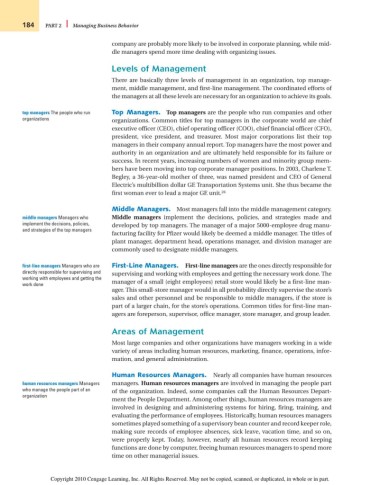Page 210 - Introduction to Business
P. 210
184 PART 2 Managing Business Behavior
company are probably more likely to be involved in corporate planning, while mid-
dle managers spend more time dealing with organizing issues.
Levels of Management
There are basically three levels of management in an organization, top manage-
ment, middle management, and first-line management. The coordinated efforts of
the managers at all these levels are necessary for an organization to achieve its goals.
top managers The people who run Top Managers. Top managers are the people who run companies and other
organizations organizations. Common titles for top managers in the corporate world are chief
executive officer (CEO), chief operating officer (COO), chief financial officer (CFO),
president, vice president, and treasurer. Most major corporations list their top
managers in their company annual report. Top managers have the most power and
authority in an organization and are ultimately held responsible for its failure or
success. In recent years, increasing numbers of women and minority group mem-
bers have been moving into top corporate manager positions. In 2003, Charlene T.
Begley, a 36-year-old mother of three, was named president and CEO of General
Electric’s multibillion dollar GE Transportation Systems unit. She thus became the
first woman ever to lead a major GE unit. 26
Middle Managers. Most managers fall into the middle management category.
middle managers Managers who Middle managers implement the decisions, policies, and strategies made and
implement the decisions, policies, developed by top managers. The manager of a major 5000-employee drug manu-
and strategies of the top managers
facturing facility for Pfizer would likely be deemed a middle manager. The titles of
plant manager, department head, operations manager, and division manager are
commonly used to designate middle managers.
first-line managers Managers who are First-Line Managers. First-line managers are the ones directly responsible for
directly responsible for supervising and supervising and working with employees and getting the necessary work done. The
working with employees and getting the
work done manager of a small (eight employees) retail store would likely be a first-line man-
ager. This small-store manager would in all probability directly supervise the store’s
sales and other personnel and be responsible to middle managers, if the store is
part of a larger chain, for the store’s operations. Common titles for first-line man-
agers are foreperson, supervisor, office manager, store manager, and group leader.
Areas of Management
Most large companies and other organizations have managers working in a wide
variety of areas including human resources, marketing, finance, operations, infor-
mation, and general administration.
Human Resources Managers. Nearly all companies have human resources
human resources managers Managers managers. Human resources managers are involved in managing the people part
who manage the people part of an of the organization. Indeed, some companies call the Human Resources Depart-
organization
ment the People Department. Among other things, human resources managers are
involved in designing and administering systems for hiring, firing, training, and
evaluating the performance of employees. Historically, human resources managers
sometimes played something of a supervisory bean counter and record keeper role,
making sure records of employee absences, sick leave, vacation time, and so on,
were properly kept. Today, however, nearly all human resources record keeping
functions are done by computer, freeing human resources managers to spend more
time on other managerial issues.
Copyright 2010 Cengage Learning, Inc. All Rights Reserved. May not be copied, scanned, or duplicated, in whole or in part.

